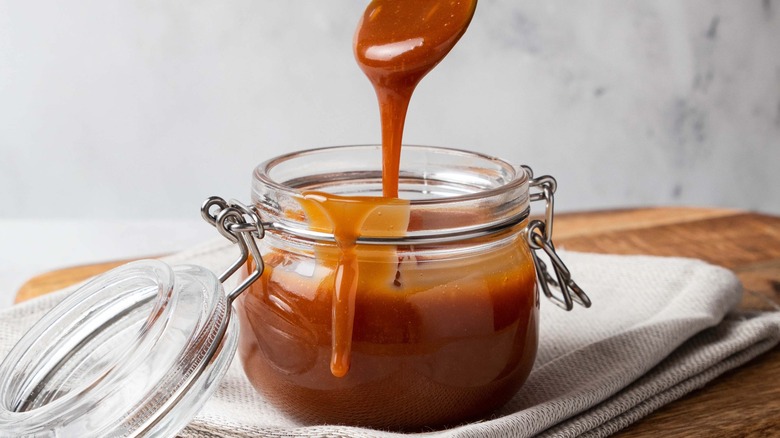The Sour Ingredient You Need To Tone Down Overly-Sweet Caramel
The flavor of caramel is a combination of sweet, buttery, toasted, and rich. But sometimes all you can taste is the sugar. This usually means that the caramel needs a bit more time on the stove. The more it cooks, the more bitter it starts to get, and this bitterness is what balances out the sweetness and gives it that toasted flavor. As long as the sugar doesn't burn, a little bit of extra time on the stove can go a long way in reducing the overwhelming sweetness of your caramel.
Sourness also works to tone down sweetness. You might've seen that some recipes call for adding a bit of lemon juice, but this doesn't affect the flavor in the way you might assume. Instead, due of its intense acidity, it prevents sugar crystals from forming, ensuring your caramel turns out smooth instead of grainy. Another sour ingredient, tamarind paste, will be much more effective at altering the sweetness of your caramel. This is because it has a tartly sweet fruitiness that comes from its main ingredient: tamarind.
Speaking with The Sydney Morning Herald, Malaysian-born chef Tony Tan recounted the importance of the tropical fruit during his childhood, saying, "It was medicine. We also used tamarind water to remove the verdigris from our copperware. We used it in our sambal to add a tangy note and a fruity sweetness. Ripe tamarind can be 10% sugar."
What is tamarind paste?
Even if you have never heard of tamarind paste before, chances are you've at least eaten a dish that contains it. It's a frequently used ingredient in many savory Asian dishes, such as pad Thai and Indian curry. It can also be found in a number of Mexican candies, as well as the popular condiment Worcestershire sauce. Tamarind paste comes from the tamarind fruit, and though you can make it fresh yourself, the paste is usually sold in jarred form at specialty grocery stores. To make it, the pulp is usually steeped in boiling water and then mashed before the seeds are filtered for a smoother texture.
The texture of tamarind paste is thick, almost syrupy, making it easy to incorporate into caramel. It has a naturally sour flavor that's somewhat reminiscent of citrus, but there are also sweet notes, which is why it's such a versatile cooking ingredient. When you mix tamarind paste into caramel, it will still taste like caramel, but it won't be nearly as sugary because the tang of the tamarind paste cuts through it.
How much tamarind paste should you add to caramel?
In her cookbook "A Splash of Soy," author Lara Lee recommends adding 25 milliliters of tamarind paste to caramel made with 70 grams of sugar. This is a solid frame of reference, but keep in mind the amount may vary slightly based on the type of tamarind paste you use. Some tamarind paste has a more liquid consistency, while others are truly paste-like. Just make sure to check the ingredients list on the bottle because you won't need to add as much to your caramel if it contains 100% tamarind. The runnier varieties are more heavily diluted with water and are, therefore, less concentrated. Either works fine, but in general, try to stay away from tamarind paste with added sugar because there's already plenty of it in the caramel.
When adding tamarind paste to caramel, for best results, don't add it along with the sugar, butter, or other ingredients. According to Lee's recipe, you'll want to prepare your caramel as you normally would, only adding the tamarind paste as soon as you take the caramel off the stove while it's still hot. Once it's cool enough to taste, you'll be able to notice a big difference in the sweetness.


